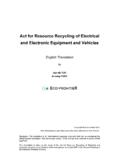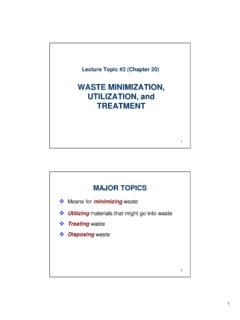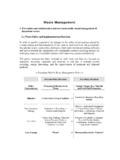Transcription of Wasting and Recycling in the United States 2000
1 Wasting AND Recycling IN THE United States 2000 GrassRoots Recycling Network 2000 Prepared by Brenda Platt and Neil Seldman Institute for Local Self-Reliance [This Web TEXT VERSION does not contain the graphics or formatting of the printed report.] About the GrassRoots Recycling Network The GrassRoots Recycling Network (GRRN) is a North American network of Recycling and community-based activists who advocate policies and practices to achieve zero waste , to end corporate welfare for waste , and to create sustainable jobs from discards. GRRN advocates changing outmoded government subsidies and tax policies that promote Wasting and inhibit resource conservation, and implementing extended producer responsibility for product and packaging waste .
2 GRRN was founded in 1995 by members of the Sierra Club Solid waste Committee, the Institute for Local Self-Reliance, and the California Resource Recovery Association. GrassRoots Recycling Network Box 49283 Athens, GA 30604-9283 Network Coordinator: Bill Sheehan 706-613-7121 Fax 706-613-7123 Email: Web site: About the Institute for Local Self-Reliance The Institute for Local Self-Reliance (ILSR) is a nonprofit research and educational organization that provides technical assistance and information to city and state governments, citizen organizations, and industry. Since 1974, ILSR has researched the technical feasibility and commercial viability of environmentally sound, state-of-the-art technologies with a view to strengthening local economies.
3 ILSR works to involve citizens, government, and private enterprise in the development of a comprehensive materials policy oriented towards local ownership, efficiency, Recycling , and maximum utilization of renewable energy sources. The Institute for Local Self-Reliance 2425 18th Street, NW Washington, DC 20009 (202) 232-4108 Fax (202) 332-0463 Email: Web site: Copyright 2000 by the GrassRoots Recycling Network. All rights reserved. Text printed on 100% postconsumer content, processed chlorine-free stock by EcoPrint. Inks are 100% soy bean based and free of environmentally toxic metals. GRRN - 2 No part of this document may be reproduced in any form or by any electronic or mechanical means, including information storage and retrieval systems, without written permission from the GrassRoots Recycling Network, Athens, Georgia.
4 Acknowledgments This report was made possible by the generous support of the Turner Foundation, The Florence and John Schumann Foundation, Merck Family Fund, Californians Against waste , and the Alameda County waste Management Authority and Recycling Board. Brenda Platt and Neil Seldman, , of the Institute for Local Self-Reliance (ILSR) researched and authored the report. ILSR research associate Kelly Lease and intern Annemie Berding contributed to the research. Mary Lou Van Deventer and Dan Knapp (Urban Ore, Berkeley, California) deserve special recognition for their thorough edits of part of this document. Special thanks to the following individuals for reviewing and improving this document: Susan Alexander, Public Media Center, San Francisco, CA Rick Anthony, Richard Anthony Associates, San Diego, CA Rick Best, Policy Director, Californians Against waste , Sacramento, CA Ed Boisson, Principal, Boisson & Associates, Brattleboro, VT Resa Dimino, Sustainable Enterprise, City Island, NY Kathy Evans, Canyon, CA Pat Franklin, Executive Director, Container Recycling Institute, Arlington, VA Lance King, Livewell Environmental Designs & Resources, Arlington, VA David Kirkpatrick, Managing Director, Sustainable Jobs Fund, Durham, NC Dan Knapp, , and Mary Lou Van Deventer, Urban Ore, Inc.
5 , Berkeley, CA Eric Lombardi, Executive Director, Eco-Cycle, Boulder, CO David Morris, Institute for Local Self-Reliance, Minneapolis, MN John Reindl, Recycling Manager, Dane County Department of Public Works, Madison, WI Bill Sheehan, , Network Coordinator, GrassRoots Recycling Network, Athens, GA Helen Spiegelman, Society Promoting Environmental Conservation, Vancouver, BC, Canada David Wood, Senior Associate, Center on Wisconsin Strategy, Madison, WI All responsibility for the views expressed in this report or for any errors in it rests with the authoring organizations. GRRN - 3 executive summary In the last decade and a half, waste prevention, reuse and Recycling have made tremendous gains. The national municipal Recycling rate has reached 28%, while many communities are surpassing 50% diversion from landfills and incinerators, and doing so cost-effectively.
6 More than 9,300 communities had curbside Recycling programs in 1998, up from 2,700 at the beginning of the decade. Reduction of private sector and industrial process wastes has similarly increased, with some businesses approaching 90% and higher waste reduction levels. The benefits of waste reduction are more far reaching than previously thought. Recycling reduces costs, creates jobs and businesses, and improves the environment and public health in myriad ways. When a pound of municipal material is recycled, industry avoids Wasting many more pounds of mining and manufacturing wastes caused by extracting and processing virgin materials into finished goods. Using recycled materials to make new products saves energy and other resources, reduces greenhouse gases and industrial pollution, and stems deforestation and damage to fragile ecosystems.
7 waste reduction also reduces the negative effects of landfilling and burning materials. For landfills, these effects include groundwater pollution, release of global warming gases, and monitoring and remediation costs that will likely span centuries. Incinerators may even be worse, as pollution is borne directly to the air as well as to the land as ash; and energy wasted by not Recycling is greater than the amount of energy produced via burning. Despite these benefits, unsustainable patterns of Wasting and consumption hinder further progress in Recycling . Recent trends indicate Wasting is on the rise and is outpacing the rise in Recycling : After several years of leveling off and then dropping, municipal Wasting increased again in 1997, both in absolute tons and on a per capita basis.
8 Materials landfilled and incinerated rose million tons in 1997 (the latest year for which data are available) as compared to 1996. Municipal Recycling rates since 1994 have increased only slightly, after rapidly increasing in the late 1980s and early 1990s. The portion of plastic, aluminum, and glass containers landfilled and burned is rising. In 1998, 75% of plastic PET (no. 1) containers were wasted, up from 60% in 1995. The Wasting rate for aluminum cans has climbed from a low of 36% in 1992 to 44% in 1998. Manufacturers are producing more products and packaging that are hard to recycle or lack recycled-content. From 1990 to 1997, plastic packaging grew five times faster by weight than plastic recovered for Recycling .
9 The waste hauling industry continues to consolidate, leading to less Recycling . Big hauling companies that are vertically integrated with Wasting facilities make more money by landfilling than Recycling . Some States are considering rescinding Recycling goals and policies. A few cities have opted to cut back their Recycling budgets. Some industries particularly the plastic GRRN - 4 industry have not followed through on commitments to utilize more recycled material. Several factors contribute to the increase in Wasting . For one, manufacturers and sellers of products and packaging usually have no responsibility for handling materials once discarded. Secondly, Recycling competes with raw materials processing and Wasting industries on an uneven economic playing field: Prices of virgin materials and products (which compete with recovered materials) exclude billions of dollars in taxpayer subsidies, and the true costs that resource extraction and manufacturing impose on the environment and public health.
10 Prices for waste disposal (which competes with reuse and Recycling for the supply of discarded materials) do not reflect the cost of perpetual landfill maintenance, among other externalities. The economic development benefits of Recycling are often overlooked ( Recycling creates at least ten times more jobs than landfills). The Introduction to this report describes the need for a new paradigm for managing resources sustainably. Zero waste is a design principle for a society that makes products with a minimum investment of natural resources and energy, and in which the end-of-life options for those products are limited to reuse , recycle, repair, and compost. Zero waste implies that the goal of public policy should be to eliminate waste rather than manage it in waste facilities.



